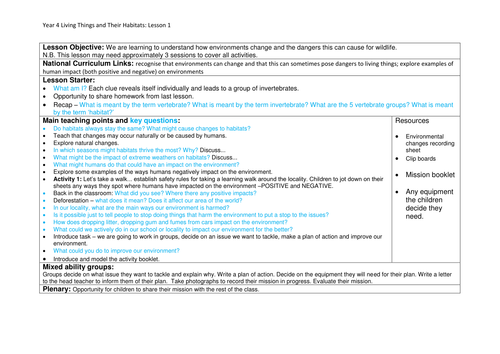



Lesson PowerPoint, planning and activities for identifying invertebrate groups and developing children's understanding of invertebrates that live in their local environment. Lots of mastery thinking required.
The sixth (final) in a series of lessons to develop children's knowledge about 'Living Things and Their Habitats,' for the 2014 primary curriculum. Links to coverage of the curriculum are explicit in the planning.
We are learning to understand how environments change and the dangers this can cause for wildlife.
An interesting 'who am I?' starter to intrigue children. Clues reveal themselves one at a time and explore each of the invertebrate groups covered in the last lesson.
Recaps, revisits and builds on prior learning on living things.
Develop's children's scientific knowledge about habitats and how they change - both through natural causes and the impacts of humans. Lots of critical thinking and explaining required.
Learning walk around the locality required - children to look out for ways humans have changed the environment - both positive and negative. Opportunity for children to discuss what they saw, particularly any positive impacts.
How do humans harm habitats? Explores deforestation, what it is and the impacts.
Opportunity for children to consider why humans harm the environment and the impacts.
Opportunity for children to consider ways to improve the environment that are relevant to their locality.
Children work in mixed ability groups to develop, carry out and evaluate a plan to improve their environment.
Lots of 'mastery' thinking required through the questions posed, for deepening and mastering learning.
This may actually take 3-4 lessons:
Introducing the learning and taking the learning walk.
Creating an action plan
Carrying out the mission
Evaluating the mission and sharing with the class.
All images have been taken from: http://search.creativecommons.org/ where no attribution is required.
The sixth (final) in a series of lessons to develop children's knowledge about 'Living Things and Their Habitats,' for the 2014 primary curriculum. Links to coverage of the curriculum are explicit in the planning.
We are learning to understand how environments change and the dangers this can cause for wildlife.
An interesting 'who am I?' starter to intrigue children. Clues reveal themselves one at a time and explore each of the invertebrate groups covered in the last lesson.
Recaps, revisits and builds on prior learning on living things.
Develop's children's scientific knowledge about habitats and how they change - both through natural causes and the impacts of humans. Lots of critical thinking and explaining required.
Learning walk around the locality required - children to look out for ways humans have changed the environment - both positive and negative. Opportunity for children to discuss what they saw, particularly any positive impacts.
How do humans harm habitats? Explores deforestation, what it is and the impacts.
Opportunity for children to consider why humans harm the environment and the impacts.
Opportunity for children to consider ways to improve the environment that are relevant to their locality.
Children work in mixed ability groups to develop, carry out and evaluate a plan to improve their environment.
Lots of 'mastery' thinking required through the questions posed, for deepening and mastering learning.
This may actually take 3-4 lessons:
Introducing the learning and taking the learning walk.
Creating an action plan
Carrying out the mission
Evaluating the mission and sharing with the class.
All images have been taken from: http://search.creativecommons.org/ where no attribution is required.
Something went wrong, please try again later.
This resource hasn't been reviewed yet
To ensure quality for our reviews, only customers who have purchased this resource can review it
Report this resourceto let us know if it violates our terms and conditions.
Our customer service team will review your report and will be in touch.
£2.35
